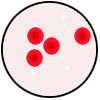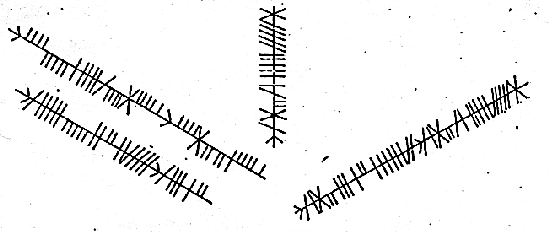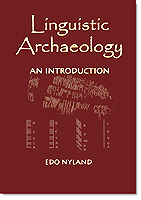
Ogam is a script found in Ireland and Scotland, inscribed mostly on stone but also on bone, ivory, bronze and silver objects. It was used in Ireland from about 350 to 800 AD by the early Irish evangelists who brought Gnostic Christianity to the island, written from the bottom up. From about 750 AD to 900 AD the Benedictine monks also used it in their inscriptions and their book the Auraicept, but they wrote it from left to right.
Academia is groping.
Many academics in different countries have tried to solve the Ogam script puzzle and all have suggested dissimilar solutions. Here are four of them.
Ogam is numerical, not linguistic.
Dr. Anthony Jackson[1] of Edinburgh University studied the inscriptions in Scotland and wrote: "It is clear that the Ogam inscriptions are numerically based and not linguistic." (p.153). When he gave the letters numbers according to the Latin alphabet he found fascinating arithmetic combinations embedded in them, based on prime numbers, and wrote: ÏThus we seem to have a battle between rival magicsÓ (p.154).
Ogam is Basque writing.
A Basque scholar from France, Dr. Henri Guiter[2], thought he could detect Basque words in the letters, however the results he obtained made very little sense. Dr. Douglas Gifford of St. AndrewÌs University agreed with Guiter that Basque could be involved and urged further study.
Ogam is Old Norse writing.
Richard A.V. Cox[3], lecturer at Aberdeen University, saw the Old Norse language in the letters and wrote: ÏThe use of the Norse language in these inscriptions suggests that the language of their composers was Old NorseÓ (p.166). Yet the results he obtained had been far from convincing.
Ogam is Celtic writing. Dr. Damien McManus[4], professor of Celtic at Trinity College in Dublin, wrote: "It can be shown without reasonable doubt that the Ogam alphabet was designed for the Irish language" (p.1). According to him, most inscriptions pointed to burials with epitaphs something like: Here lies Johnnie mourned by Mary. The problem was that no, or only a few, burials were ever found underneath the stones and his translations were hardly persuasive.
The Rh-negative clue.
 I found Dr. Jackson's book while in Scotland researching the origin of Scottish and Irish geographical names and had found that many of them could be translated with the Basque dictionary. This finding was supported by the blood type of many of the inhabitants who had Rh negative blood, in about the same proportion as the Basque people in Spain. Dr. Cavalli-Sforza, in his article, "Genes Peoples and Languages" (November 1991 issue of Scientific American) had shown the world distribution of peoples with Rh negative blood and concluded that a sea migration was involved from NW Africa north along the west coast of Europe as far north as arctic Norway, the only peoples in the world to have 25% or higher frequency of this blood type. One of the tribes involved in this migration was still speaking their Neolithic language, the Basques, so it was logical to consider the possibility that the entire migration could have spoken that language. Indeed, a great many geographical names from Morocco, Euskadi, Ireland, Scotland and Norway could be translated into meaningful descriptions or comments with the Basque dictionary. I found Dr. Jackson's book while in Scotland researching the origin of Scottish and Irish geographical names and had found that many of them could be translated with the Basque dictionary. This finding was supported by the blood type of many of the inhabitants who had Rh negative blood, in about the same proportion as the Basque people in Spain. Dr. Cavalli-Sforza, in his article, "Genes Peoples and Languages" (November 1991 issue of Scientific American) had shown the world distribution of peoples with Rh negative blood and concluded that a sea migration was involved from NW Africa north along the west coast of Europe as far north as arctic Norway, the only peoples in the world to have 25% or higher frequency of this blood type. One of the tribes involved in this migration was still speaking their Neolithic language, the Basques, so it was logical to consider the possibility that the entire migration could have spoken that language. Indeed, a great many geographical names from Morocco, Euskadi, Ireland, Scotland and Norway could be translated into meaningful descriptions or comments with the Basque dictionary.
The language of Ogam is Basque.
The knowledge that Basque had been used in Ireland and Scotland agreed with Dr. Guiter and Dr. Gifford's findings, even though their results had been unconvincing. But Dr. Jackson also wrote, "All research along linguistic lines has ground to a halt, unsurprisingly..." (p.135) which remark I took as a challenge because these 1500+ year old inscriptions were so well executed and had been preserved for so long, that they just had to tell us something important. While on the Isle of Barra I buried myself for three days in my B&B room and discovered that the ÏmeaninglessÓ lists of letters of the inscriptions contained Basque sentences using words starting with vowel-consonant-vowel (VCV), which about half of the Basque vocabulary has. Ogam used the first three letters of these Basque words, with the VCVs linked together by the vowels, just like Basque words e.g: ohitura (custom), composed of three VCVs: ohi-itu-ura, note the vowels on either side of the hyphens are the same; ohi (habit) itungaitz (disagreeable) urratu (to break). Ohitura therefore had the built-in shorthand sentence saying: "Break that disagreeable habit."
This knowledge I then applied to the Ogam inscriptions, filled in the missing vowels, and translated my first Ogam inscription found in Scotland into a good sentence. I sent my findings to Dr. Jackson who did not answer but instead sent me a second book of his, in which he had written: "There is a popular theory that they are Basque but this does not work either." (p.118) He hadn't looked very hard at what I wrote.
Two examples from Scotland.
There appear to be no true Scottish Ogam inscriptions. All Ogams found in Scotland were made by Irish evangelists who used pre-Christian standing stones to tell people to come to Christ and other important statements. Here is one, located in the Shetlands and called: Cunningsburgh 3a:
ETTEKA, which has only one vowel missing: et.-.te-eka;
et. eti etikoa ethical
.te ite itegun work performed, hard work
eka eka ekandu make it a habit
"Make ethical behaviour and hard work a habit".
|
A second one, more difficult; is called Buckquoy, located on Mainland, Orkney:
|
ETMIKMSSALLK which has six vowels missing: et.-.mi-ik.-.m.-.s.-.sa-al.-.l.-.k.:
et. eti etika ethics
.mi imi imitagarri exemplary
ik. ika ikasbide teachings
.m. amo amodio love
.s. oso oso sincere
.sa osa osatu to heal
al. ala alaitu to fill with happiness
.l. ale alen total
.k. eku ekurutasun peace of mind
"Exemplary teachings of ethics and sincere love will heal you and fill you with total happiness and peace of mind." |
Two examples from Ireland.
A large variety of topics are discussed in Irish inscriptions, from jokes to disaster stories and funerals. The first one is one of the longest known and tells the tragic story of a woman falling down a cliff into the ocean. It is inscribed on a silver bracelet which may be seen in the treasury of the National Museum in Dublin.
The Ballispellan Broche (#27).

The silver Ballispellan broche is located in the Treasury of the National Museum of Ireland, Dublin. The inscription became a challenge for me because the inscription is so perfectly done and it is one of the longer known.
|
CNAEMSECHCELLACH MINODORMUAD MAELMAIRE MAELUADAIG
Or, in Basque letters and in VCV format:
.K.NA.EM.SEK.H.KEL.LAK.H. .MINODOR.MU.AD. .MA.EL.MA.IRE .MA.ELU.ADA.IG.
.k. ika ikaratu to be frightened
.na ana anai brother
a.e ahe aihezka grieving
em. ema emazte wife
.se ase aserregorri fury
ek. eka ekaizte storm
.h. ahi ahituezin endless
.ke ike ikertu to explore, to search
el. ele ele story
.la ela elaberriti talker, story teller
ak. aka akabu dead
.h. aha ahaideko relative
.mi ami amilketa fell down cliff
ino ino inolaz somehow
odo odo odolgaizto violently
or. ora oratu to seize, to grab
.mu amu amuzki bait
u.a uha uharka water body
ad. ada ada roaring
.ma amai amaitu endlessly
a.e aihe aihenatu to disappear
el. ele elegile storyteller
.ma ama emakumezko woman
a.i ai aitortu to witness
ire ire irenste devoured, swallowed
ema emai emaitza ending
a.e aihe aihenegarri lamentable
elu elu elurtu to freeze
u.a uha uhalde coast
ada ada adarreztatu to cover with branches
a.i ahi ahizpa sister (of a woman)
ig. iga igar dead
My frightened brother and his grieving wife searched endlessly in the fury of the storm. The story teller's dead relative had somehow fallen violently down a cliff, was seized like bait by the endlessly roaring water and then disappeared. The story teller had witnessed the woman being devoured by the sea. The lamentable ending on that frozen coast was the covering of her dead sister with branches. |
KINGULBIN EAST (#1086).
Two inscriptions are found on a bronze hanging bowl, probably an incense burner, dug up from a peat bog in County Kerry. McManus (7.6) writes: "They are inscribed along the upper surface of the rim and on one of the escutcheons." This bowl may be seen in the National Museum in Dublin. Here is one of the two inscriptions:
|
Bladnak kuilen:
.b.-.la-ad.-.na-ak. .ku-ile-en.
.b. abe abe cross
.la ela ela story
ad. ade adelatu to prepare
.na ena ena that
ak. aka akabu ultimate, superior
.ku eku ekurutasun peace of mind
ile ile ilezin everlasting
en. ene eneganatu to come over me/us
"The story of the cross prepares us for that ultimate everlasting peace of mind (which will) come over us. " |
|
A Traslation Program from ViewZone
In his excellent book, Linguistic Archaeology, An Introduction by Edo Nyland, the author provides a comprehensive glossary of Basque root words. Gary Vey has programmed this database using JavaScript and has made this program available here in an attempt to demonstrate the methodology of Mr. Nyland's algarythm. We encourage those interested to use the program and to give us feedback and photographic documantation of ogam script found both in the Americas and abroad.We also highly recommend this book for anyone seriously interested in petroglyphs or ancient writing and culture.
Click Here for Ogam Translation Program
Comments? E-mail Viewzone | 
ORDER BOOK
from
EDO NYLAND
HERE |
You may also enjoy this previous article on suspected Ogam script found in Colorado. References
1 Jackson, Anthony. "The Symbol Stones of Scotland". Orkney Press, 1984.
2 Guiter, Henri. "La Langue des Pictes". Boletin de la Real Sociedad Vascongada de lost Amigos del Pais, XXIV, San Sebastian 1968, pages 281-322.
Guiter, Henri. "La Pensée Pictes". Bulletin de l'Association Guillaume Budé, XXIX, Paris 1970, pages 259-271.
3 Cox, Richard A.V. "The Language of the Ogam inscriptions of Scotland". Department of Celtic, University of Aberdeen, Scotland, 1999.
4 Damien McManus. "A Guide to Ogam". Maynooth Monograph #4. Maynooth, Ireland: An Sagert 1991.
5 Jackson, Anthony. "Pictish Symbol Stones?". Monograph #3, Edinburgh. The Association of Scottish Ethnography, 1993.
|



 I found Dr. Jackson's book while in Scotland researching the origin of Scottish and Irish geographical names and had found that many of them could be translated with the Basque dictionary. This finding was supported by the blood type of many of the inhabitants who had Rh negative blood, in about the same proportion as the Basque people in Spain. Dr. Cavalli-Sforza, in his article, "Genes Peoples and Languages" (November 1991 issue of Scientific American) had shown the world distribution of peoples with Rh negative blood and concluded that a sea migration was involved from NW Africa north along the west coast of Europe as far north as arctic Norway, the only peoples in the world to have 25% or higher frequency of this blood type. One of the tribes involved in this migration was still speaking their Neolithic language, the Basques, so it was logical to consider the possibility that the entire migration could have spoken that language. Indeed, a great many geographical names from Morocco, Euskadi, Ireland, Scotland and Norway could be translated into meaningful descriptions or comments with the Basque dictionary.
I found Dr. Jackson's book while in Scotland researching the origin of Scottish and Irish geographical names and had found that many of them could be translated with the Basque dictionary. This finding was supported by the blood type of many of the inhabitants who had Rh negative blood, in about the same proportion as the Basque people in Spain. Dr. Cavalli-Sforza, in his article, "Genes Peoples and Languages" (November 1991 issue of Scientific American) had shown the world distribution of peoples with Rh negative blood and concluded that a sea migration was involved from NW Africa north along the west coast of Europe as far north as arctic Norway, the only peoples in the world to have 25% or higher frequency of this blood type. One of the tribes involved in this migration was still speaking their Neolithic language, the Basques, so it was logical to consider the possibility that the entire migration could have spoken that language. Indeed, a great many geographical names from Morocco, Euskadi, Ireland, Scotland and Norway could be translated into meaningful descriptions or comments with the Basque dictionary. 